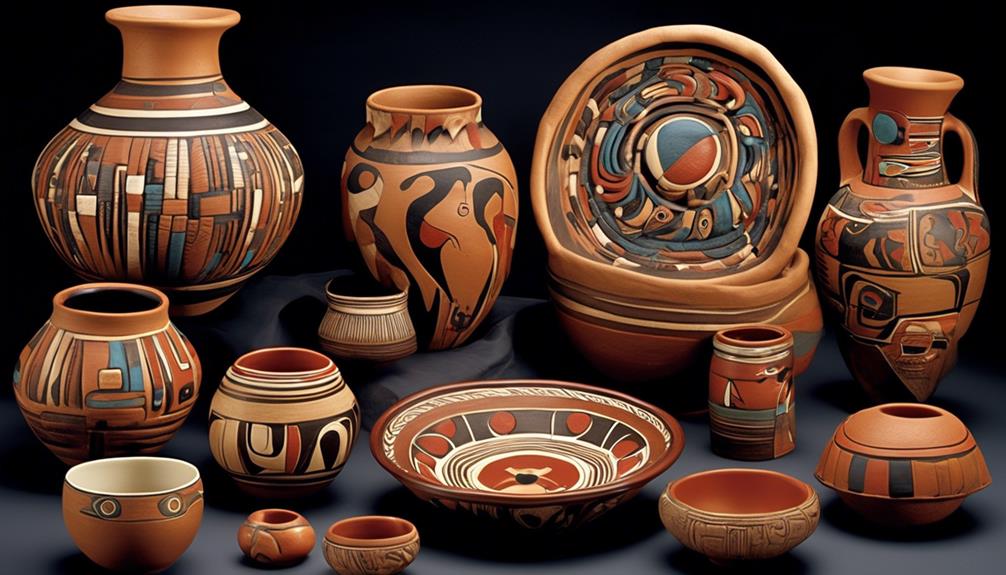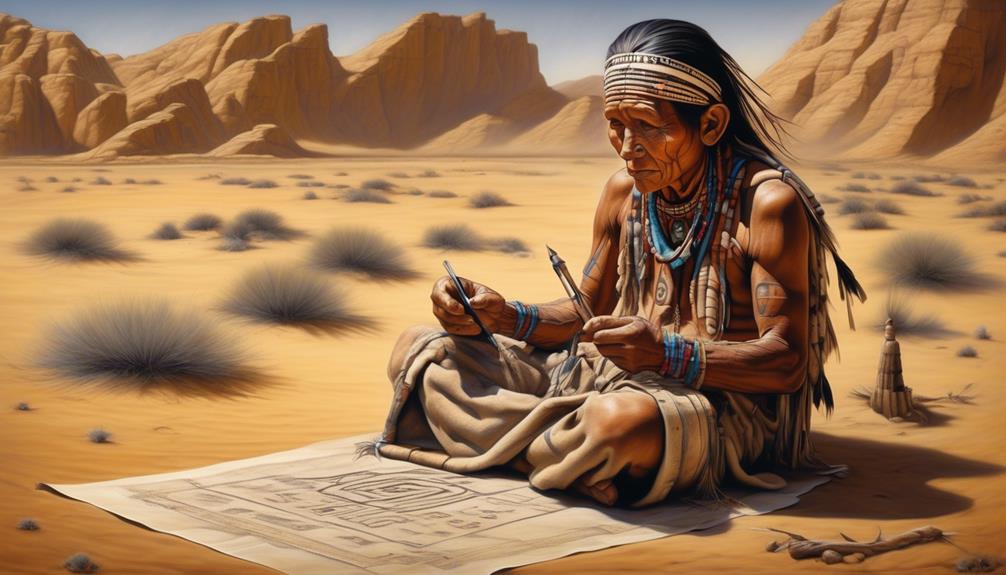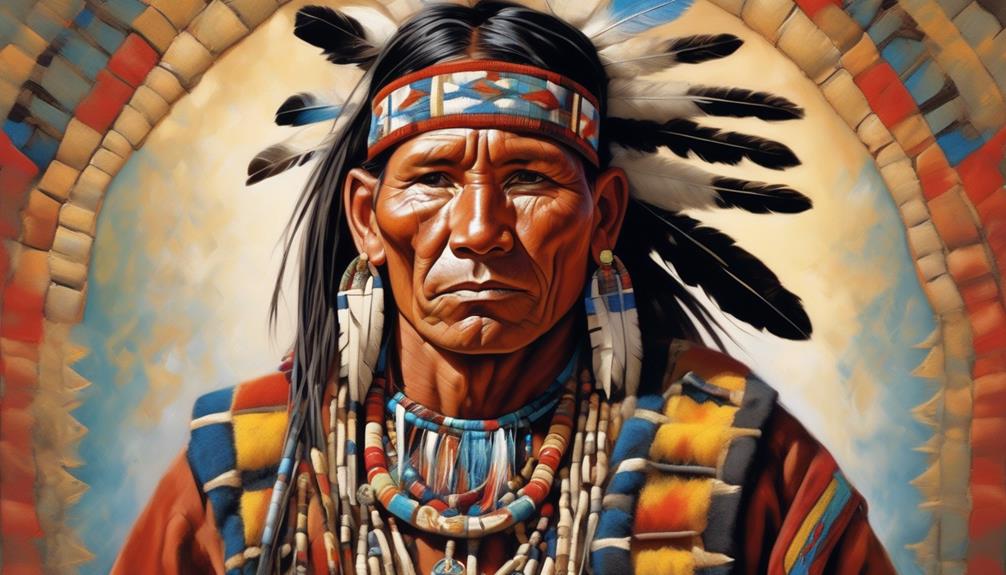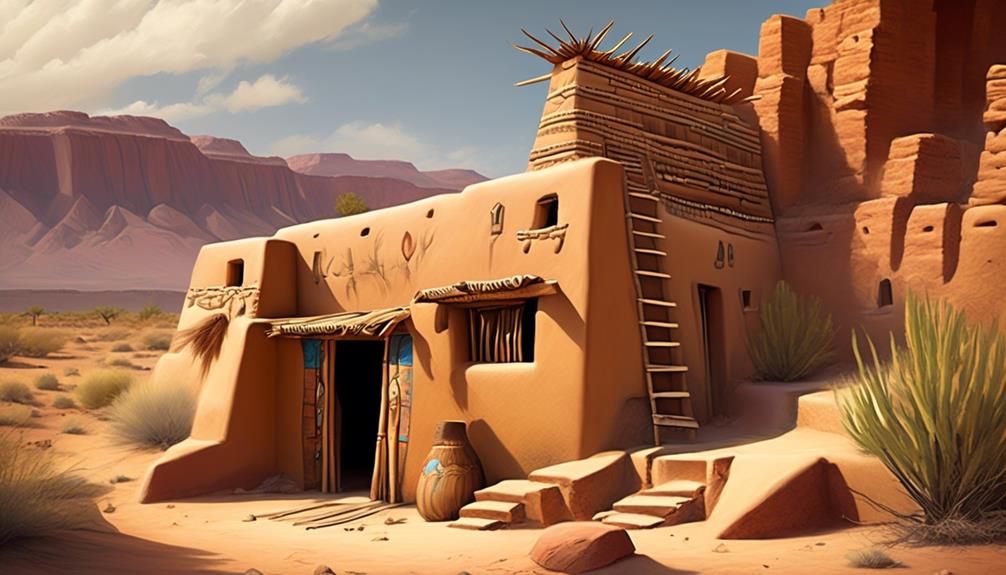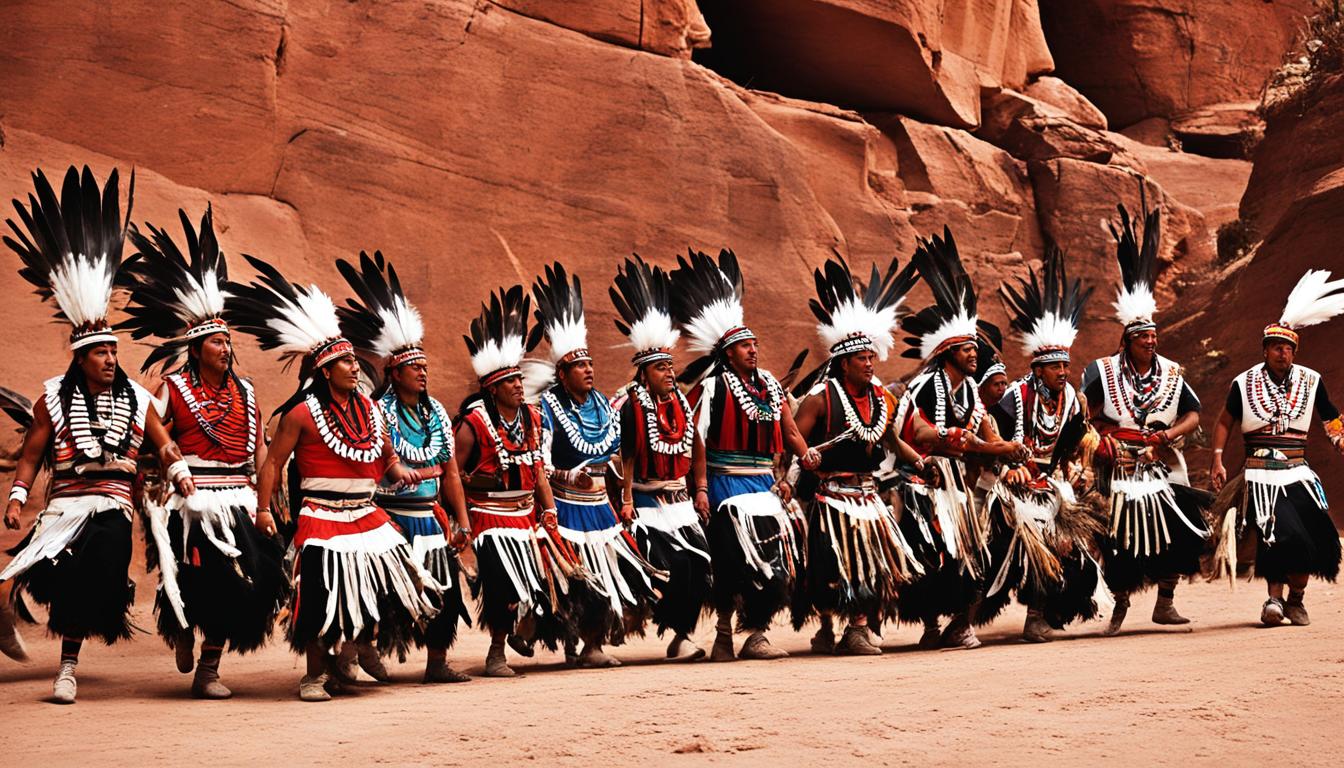The Hopi Tribe, a Native American community, holds deep cultural beliefs and spiritual practices. Their bond with the land and nature is central to their religious beliefs and way of life. The Hopi people view humans and the natural world as one, seeing all living beings as interconnected and sacred.
Throughout their history, the Hopi Tribe has faced challenges in preserving their cultural identity. Assimilation efforts by the U.S. government have attempted to strip them of their beliefs and traditions. Yet, the Hopi people have shown remarkable resilience in maintaining their cultural heritage.
“The Man Who Killed the Deer” by Frank Waters is a novel that delves into the Hopi Tribe’s struggle to preserve their cultural identity in the face of assimilation. It offers insights into the Hopi beliefs and the complex dynamics between traditional practices and the influences of the modern world.
In this article, we will explore the Hopi Tribe’s beliefs, their rich history, spiritual practices, prophecies, and the challenges they face in preserving their culture. Join us on this journey to gain a deeper understanding of the Hopi Tribe and their contributions to Native American culture.
Key Takeaways:
- The Hopi Tribe’s beliefs are deeply rooted in their ancient culture and emphasize the oneness between humans and nature.
- The Hopi Tribe has a rich history, encompassing legends, creation stories, and a strong connection to the land and environment.
- Spiritual practices and customs play a crucial role in the Hopi way of life, addressing various aspects of their existence.
- The Hopi Tribe is known for its prophecies, which provide insights into the future and guide their way of life.
- The Hopi people have faced assimilation efforts, but their cultural beliefs and practices have remained resilient.
The Hopi Tribe: A Living Culture with a Rich History
The Hopi Tribe stands as one of the oldest living cultures in recorded history, having inhabited Northeastern Arizona for thousands of years. Although their current reservation encompasses only a fraction of their original land, the Hopi people have managed to preserve their rich history and cultural heritage. Their beliefs, deeply rooted in their agricultural practices and spiritual customs, continue to shape their way of life.
The Hopi Tribe’s connection to their land and environment is profound. Legends and creation stories passed down through generations underscore their strong bond with nature. These narratives shed light on the origins of their beliefs, traditions, and values, serving as a testament to their enduring cultural identity.
Central to their beliefs is the significance of corn, which plays a vital role in Hopi culture. Corn represents sustenance, prayer offerings, and the embodiment of Hopi values. Their agricultural practices, shaped by centuries of knowledge, reflect their deep understanding of the natural world and their commitment to sustainable living.
Throughout their history, the Hopi people have faced numerous challenges, including forced assimilation efforts by the U.S. government. Despite these adversities, their beliefs have remained resilient, serving as the foundation of their cultural preservation.
“Our beliefs are what guide us, rooted in the stories of our ancestors, and intertwined with the natural world. They give us strength, hope, and a sense of belonging in an ever-changing world.”
The Hopi Tribe’s cultural resilience is a testament to the importance of their beliefs and customs. Their unwavering dedication to passing down their traditions to future generations ensures the continuity of their way of life. In doing so, they preserve a profound wisdom that offers valuable insights into our relationship with the environment and the interconnectedness of all living beings.
To gain a deeper understanding of Hopi culture, let’s explore some of their traditional beliefs, legends, and creation stories:
Hopi Legends and Creation Stories
The Hopi Tribe has a rich oral tradition that encompasses a diverse range of legends and creation stories. These narratives provide insights into the Hopi worldview, their understanding of the natural world, and the origins of their cultural practices.
- The Legend of the Emergence: This creation story explains how the Hopi people emerged from the underworld to the present world. It emphasizes their deep connection to the land and their spiritual beliefs.
- The Butterfly Maiden: This story centers around the Butterfly Maiden, a revered figure in Hopi culture associated with fertility and the emergence of life. It underscores the importance of balance and harmony in the natural world.
- The Kachina traditions: The Hopi are known for their intricate Kachina ceremonies, where masked dancers impersonate ancestral spirits. These ceremonies play a vital role in Hopi spiritual practices, ensuring the well-being of the community and the continuation of Hopi customs.
These legends and creation stories offer a glimpse into the richness and complexity of Hopi beliefs, highlighting their reverence for nature, spirituality, and the interconnectedness of all life.
H3 provides a deeper understanding of these beliefs, we will explore the various spiritual practices and customs of the Hopi Tribe.
Hopi Spiritual Practices and Customs
In the Hopi culture, spiritual practices are an integral part of daily life. The Hopi people have a deep reverence for nature and believe in the interconnectedness and sacredness of all living organisms. Their spiritual customs and ceremonies encompass various aspects of life, from fertility and harvest to healing and community well-being.
One of the central aspects of Hopi spiritual practices is the performance of ceremonies. These ceremonies are conducted to maintain balance and harmony in the world. They serve as a way to honor the spiritual forces and entities that guide and protect the Hopi community. Through prayers, songs, and dances, the Hopi people seek to strengthen their connection with the natural and spiritual realms.
Ceremonies are typically conducted by Hopi religious leaders, known as kikmongwis, who have deep knowledge of the rituals and customs passed down through generations. These ceremonies often feature intricate masks, colorful costumes, and traditional instruments such as rattles and drums. They offer a visually captivating and spiritually enriching experience.
“Our ceremonies are not just rituals, but profound spiritual expressions that connect us to our ancestors and the energies of the universe. They remind us of our place in the world and the responsibilities we have as stewards of the land.”
One of the prominent Hopi ceremonies is the Kachina ceremony. Kachinas are spirit beings that represent various aspects of nature and serve as intermediaries between the Hopi people and the spiritual world. The Kachina ceremony involves the intricately crafted Kachina dolls, which are beautifully adorned and believed to embody the spirit of the respective Kachina. The ceremony is performed to ensure abundant harvests and the well-being of the community.
The Snake Dance is another significant ceremony that takes place in late August. During this event, Hopi men dance with live snakes, symbolizing their connection to nature and praying for rainfall and fertility. The Snake Dance is a powerful demonstration of the Hopi’s close relationship with the natural world.
Aside from ceremonies, the Hopi people have various customs that are deeply rooted in their spiritual beliefs. For example, the Hopi practice of corn farming is not just an agricultural activity but a spiritual endeavor. Corn is considered a sacred crop, embodying the spirit of the Hopi people and serving as a vital element in their religious rituals and ceremonies.
Overall, Hopi spiritual practices and customs are a testament to the profound spiritual connection the Hopi people have with the natural world. Through their ceremonies and customs, they strive to maintain harmony and balance in both their own lives and the greater world around them.

| Ceremony | Description |
|---|---|
| Kachina Ceremony | A ritual honoring the Kachina spirits, with intricately crafted Kachina dolls representing various natural forces. |
| Snake Dance | A dance performed with live snakes to pray for rain, fertility, and the well-being of the community. |
| Corn Farming | The cultivation of corn as a sacred crop, intricately tied to Hopi spiritual beliefs and practices. |
Hopi Prophecies: Insights into the Future
The Hopi Tribe is renowned for their prophecies, which offer unique insights into the future and serve as a guiding force in their way of life. These prophecies encompass various aspects, including the environment, natural disasters, and the overall well-being of humanity. The Hopi firmly believe that their spiritual practices and adherence to their cultural beliefs are indispensable for the survival of the world.
As stewards of the land, the Hopi view their prophecies as a powerful reminder to maintain a harmonious relationship with nature. They understand that their actions have significant consequences not just for themselves, but for all living beings. By diligently following their spiritual practices and embracing their cultural beliefs, the Hopi tribe strives to create a balanced and sustainable world.
“Our prophecies guide us in preserving the sacred bond between humans and the natural world. They remind us of the importance of our role as caretakers of the Earth.”
The Hopi’s prophetic insights have withstood the test of time, providing valuable wisdom for navigating the complexities of the future. These prophecies serve as a beacon of hope, urging us to embrace unity, respect for nature, and compassion for one another. By heeding the messages conveyed in these prophecies, we can work towards building a better tomorrow.
Next, we will delve into the challenges the Hopi Tribe has faced in preserving their cultural beliefs and explore the ways they have addressed these obstacles.
Assimilation Efforts and the Hopi Identity
The Hopi Tribe has endured significant assimilation efforts by the U.S. government throughout history. These efforts aimed to erode their cultural beliefs, including their religion, and assimilate them into mainstream society. However, the Hopi people have demonstrated remarkable resilience in maintaining their strong sense of identity and resisting assimilation.
The Hopi cultural beliefs and practices are deeply intertwined with their way of life. They serve as a foundation for their community, guiding their interactions with one another and shaping their relationship with the natural world. Despite external pressures, the Hopi Tribe continues to pass down their beliefs and traditions to future generations, ensuring the preservation of their unique cultural heritage.
One key element of the Hopi identity that assimilation efforts have targeted is their religion. The Hopi religion is centered around a profound reverence for nature, recognizing the interconnectedness of all living beings. Through their religious ceremonies and practices, the Hopi people maintain a harmonious relationship with the land and seek to maintain balance and harmony in the world.
“Our cultural beliefs and practices are not just artifacts of the past; they are the essence of who we are as a people. They give us strength, guide our actions, and provide us with a sense of purpose.”
Despite attempts to suppress their cultural beliefs and practices, the Hopi Tribe remains steadfast in preserving their identity and passing it on to future generations. Their commitment to their heritage is a testament to the enduring power and significance of their cultural beliefs and values.
Hopi Cultural Beliefs and Values
The Hopi cultural beliefs encompass a deep respect for the natural world, a strong sense of community, and a commitment to maintaining harmony in all aspects of life. Key cultural values include:
- Respect for the land and all living beings
- Collaboration and communal decision-making
- Spiritual connection to nature
- Generosity and sharing
- Maintaining balance and harmony
These cultural beliefs and values are deeply ingrained in the Hopi way of life and have played a vital role in their survival as a distinct and resilient community.
The Power of Cultural Resistance
The Hopi Tribe’s resistance to assimilation efforts is a testament to the power of cultural identity and the deep significance of their beliefs. Despite historical challenges, the Hopi people have remained resilient and committed to preserving their cultural heritage.
By embracing their cultural practices, the Hopi Tribe maintains a strong connection to their ancestors, their land, and their values. This cultural resistance ensures the continuation of their beliefs and serves as a powerful statement of their distinct identity.
A Glimpse into the Hopi Identity
“Our cultural heritage is a precious gift that we cherish. It is who we are, where we come from, and where we are headed. We take pride in our identity and remain steadfast in our commitment to preserving it.”
By preserving their cultural beliefs and resisting assimilation, the Hopi Tribe upholds their unique identity and contributes to the diverse tapestry of indigenous cultures. Their cultural heritage serves as an inspiration to honor and respect the rich traditions of indigenous communities around the world.
| Assimilation Efforts and the Hopi Identity | Cultural Beliefs and Values | The Power of Cultural Resistance |
|---|---|---|
| Attempts to erode Hopi cultural beliefs and traditions | Respect for the land and all living beings | Preservation of cultural beliefs and practices |
| Significance of Hopi religion in their identity | Collaboration and communal decision-making | Strength in cultural resistance |
| Preservation of cultural beliefs for future generations | Spiritual connection to nature | Power of cultural identity |
The Man Who Killed the Deer: A Reflection of Hopi Beliefs
The novel “The Man Who Killed the Deer” by Frank Waters provides a compelling portrayal of the Hopi Tribe’s beliefs, cultural practices, and spiritual traditions. The story revolves around the main character, Martiniano, who grapples with his Hopi identity in the face of influences from the dominant white culture. Through Martiniano’s journey, readers gain insights into the intricacies and wisdom of Hopi beliefs and cultural traditions, creating a deeper understanding of the Hopi Tribe’s unique worldview.
In the novel, the Hopi belief in the sanctity of all life emerges as a central theme. It highlights the interconnectedness and interdependence of all living beings, emphasizing the importance of respecting and honoring the natural world. The consequences of violating this belief are also explored, underscoring the significance of upholding Hopi cultural values.
“The Man Who Killed the Deer” vividly captures the complexities of the Hopi Tribe’s cultural beliefs and spiritual practices. It offers a profound reflection on the challenges faced by individuals torn between cultural heritage and the influences of an external world.”
Through vivid storytelling and descriptive imagery, the novel delves into Hopi legends and oral traditions. These legends provide valuable insights into the Hopi Tribe’s rich cultural history and mythological heritage. They give readers a glimpse into the spiritual practices, rituals, and ceremonies that form the foundation of Hopi culture.
“The Man Who Killed the Deer” serves as a medium for preserving Hopi legends and cultural beliefs, allowing readers to engage with the ancient wisdom and profound spiritual connections embedded within Hopi traditions. It is through works like these that the Hopi Tribe’s cultural heritage continues to thrive, inspiring generations to value and uphold the teachings of their ancestors.
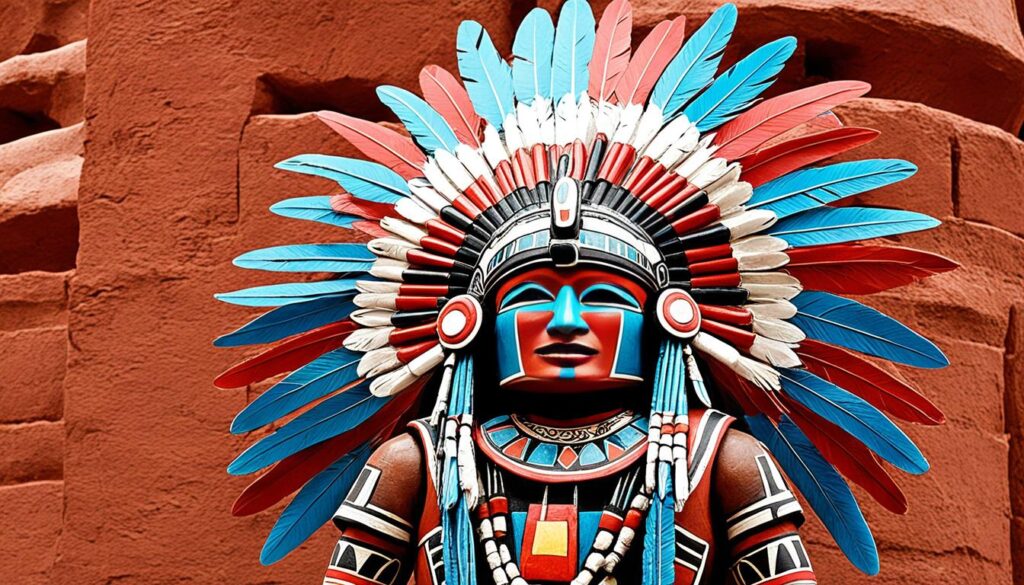
Key Themes Explored in “The Man Who Killed the Deer”
| Themes | Description |
|---|---|
| Hopi Identity | Explores the internal conflicts faced by Hopi individuals caught between their cultural heritage and external influences. |
| Sanctity of All Life | Highlights the Hopi belief in the interconnectedness and interdependence of all living beings, emphasizing the importance of respecting and honoring the natural world. |
| Hopi Legends | Showcases the rich mythological heritage of the Hopi Tribe through engaging storytelling and oral traditions. |
| Spiritual Practices | Explores the rituals, ceremonies, and spiritual practices that form the foundation of Hopi culture. |
Hopi Agriculture and its Spiritual Significance
In the Hopi culture, agriculture holds a profound significance that extends beyond sustenance and nourishment. It is deeply intertwined with their spiritual beliefs and customs, shaping their connection to the land and their cultural identity.
Living in the arid landscape of Northeastern Arizona, the Hopi people have developed unique and sustainable farming methods that allow them to thrive in challenging conditions. Their agricultural practices are a testament to their profound respect for nature and their deep understanding of the interconnectedness of all life.
At the heart of Hopi agriculture lies the sacred duty of cultivating crops. The act of growing food is seen as a spiritual practice, a way to maintain their connection with the land and honor their ancestors. It is a symbolic representation of their cultural beliefs and an expression of gratitude for the bounties provided by the earth.
Corn, in particular, holds tremendous significance in Hopi agriculture. It is not merely a staple crop but a sacred symbol of sustenance, nourishment, and the embodiment of Hopi culture. The Hopi offer prayers and perform ceremonies throughout the corn-growing season, recognizing its vital role in their lives and the spiritual sustenance it provides.
“The act of growing crops is a solemn undertaking for us. It is a profound acknowledgment of our intimate connection with the land and our responsibility as stewards of the earth.”
By nurturing their crops and practicing sustainable agriculture, the Hopi people demonstrate their profound respect for the natural world. Their agricultural practices serve as a reminder of the importance of harmony, balance, and reciprocity with the environment.
| Hopi Agriculture Practices | Spiritual Significance |
|---|---|
| Terraced farming | Symbolizes the harmony between humans and the land, ensuring optimal water usage in arid conditions. |
| Seed selection and preservation | Preserves the genetic heritage of crops and maintains the link to ancestral knowledge. |
| Crop rotation | Ensures soil fertility and demonstrates the understanding of the delicate balance within nature. |
| Drought-tolerant varieties | Adapts to the challenging desert environment and reflects the resilience of the Hopi people. |
Through their agricultural practices, the Hopi people exemplify the intrinsic connection between spirituality, culture, and the land. Their farming traditions are a testament to their profound sense of responsibility as guardians of the earth and their unwavering commitment to preserving their cultural beliefs and practices.
Hopi Language: Preserving a Key Element of Hopi Identity
The Hopi language is not only a means of communication but also a fundamental pillar of Hopi identity and culture. As an Uto-Aztecan language, it is spoken by a relatively small number of people, making it all the more important to preserve and protect. The Hopi language encompasses unique concepts and worldviews that are deeply intertwined with Hopi cultural beliefs and traditions. By preserving the Hopi language, we can ensure the cultural integrity of the tribe and pass down their beliefs to future generations.
The Power of Language in Shaping Cultural Identity
Language serves as more than just a tool for communication; it shapes our perception of the world and influences our cultural identity. The Hopi language contains specific words and expressions that capture the essence of Hopi beliefs, values, and traditions. These linguistic nuances reveal the depth of Hopi cultural heritage and provide a window into their worldview.
“Language is the roadmap of a culture. It tells you where its people come from and where they are going.” – Rita Mae Brown
Language acts as a conduit for passing on the wisdom and knowledge accumulated by a community over centuries. Through their native tongue, the Hopi people can express the sacredness of their land, the interconnectedness of all living beings, and the importance of harmony with nature.
Preserving the Hopi Language: A Sacred Duty
Preserving the Hopi language is not only a matter of cultural heritage but also a sacred duty for the Hopi Tribe. Efforts are underway to document, teach, and revitalize the language, ensuring its survival for future generations. Hopi language programs, immersion schools, and oral history projects play a crucial role in this endeavor.
The Hopi Tribe recognizes that language serves as a key thread that binds the community together, strengthening their cultural identity and reinforcing their connection to their ancestors. By revitalizing and promoting the use of the Hopi language, they safeguard their heritage and create a pathway for future generations to embrace their cultural beliefs and practices.
Building Bridges through Language
The preservation of the Hopi language not only benefits the Hopi Tribe but also fosters understanding and respect among different cultures. Language serves as a bridge that connects people and promotes intercultural dialogue. Through language, we gain insight into the traditions and values of others, fostering a greater appreciation for the diversity of human experiences.
By supporting efforts to preserve the Hopi language, we contribute to the rich tapestry of cultural diversity. We recognize the value of linguistic heritage and the importance of protecting indigenous languages from the threat of extinction. Embracing and learning from the Hopi language allows us to deepen our understanding of their beliefs and traditions, promoting mutual respect and cultural harmony.
In conclusion, the Hopi language is not just a means of communication but a conduit for preserving and transmitting the cultural beliefs and traditions of the Hopi Tribe. By safeguarding this unique and sacred language, we ensure the continuity of Hopi identity and foster a deeper understanding and appreciation of their rich heritage. Let us join hands in supporting the efforts to preserve the Hopi language, recognizing its power to bridge cultures and enrich our collective human experience.
Challenges to Hopi Preservation and Ways to Address Them
The preservation of Hopi cultural beliefs and practices faces several challenges in the modern world. Factors such as the influence of modern society, education, and economic pressures can lead younger generations to stray from the traditional Hopi traditions. However, there are initiatives in place that aim to promote and sustain Hopi culture, ensuring its preservation for future generations.
One of the key challenges is the influence of modern society on the younger Hopi population. With the advent of technology and globalization, younger individuals may be more exposed to outside influences that can divert their focus from their cultural beliefs and practices. Keeping the younger generation engaged and connected to their Hopi heritage becomes crucial in preserving the cultural identity of the tribe.
Educational facilities play a vital role in addressing this challenge. Promoting cultural education within schools, both on and off the reservation, can help instill a sense of pride in Hopi cultural beliefs. By incorporating Hopi history, traditions, and practices into the curriculum, younger generations can develop a deeper understanding and appreciation for their heritage.
Hopi language preservation projects are also essential in maintaining the cultural integrity of the tribe. Language carries the essence of cultural beliefs and values, and without it, the transmission of Hopi traditions becomes more challenging. Supporting initiatives that document and teach the Hopi language can safeguard the rich oral traditions and ensure their continuity.
Service groups and organizations dedicated to the preservation of Hopi culture also play a crucial role. These groups focus on raising awareness, organizing cultural events, and providing resources to support Hopi traditions. Collaborating with these organizations and participating in their initiatives can contribute to the ongoing preservation of Hopi cultural beliefs and practices.
“Preserving Hopi culture requires a collective effort that involves the entire community. By working together to address the challenges we face, we can ensure the continuation of our cultural heritage.”
Efforts to Address the Challenges
Efforts to address the challenges in Hopi preservation include:
- Strengthening cultural education in schools to instill pride in Hopi cultural beliefs.
- Supporting language preservation projects to safeguard the Hopi language.
- Collaborating with service groups and organizations focused on promoting and sustaining Hopi culture.
- Organizing cultural events and initiatives to raise awareness and promote Hopi cultural practices.
| Challenges | Addressing Strategies |
|---|---|
| Influence of modern society | Strengthening cultural education in schools |
| Educational pressures | Supporting language preservation projects |
| Globalization and assimilation | Collaborating with service groups and organizations |
| Economic factors | Organizing cultural events and initiatives |
By acknowledging these challenges and actively participating in initiatives that promote Hopi cultural preservation, we can ensure the rich heritage of the Hopi Tribe continues to thrive for generations to come.
The Value of Hopi Culture: A Reflection on its Importance
The Hopi culture holds immense value, not only for the Hopi tribe itself but also for the American people as a whole. The preservation of Hopi beliefs and practices is crucial in our society, as it offers us a unique perspective and teaches us valuable lessons about our relationship with nature and the environment.
The Hopi Worldview: A Deeper Connection to Nature
The Hopi people embody a deep spiritual connection to nature that is ingrained in their cultural beliefs. Their worldview emphasizes the interconnection of all living beings and the importance of maintaining harmony with the natural world.
“We understand that we are a part of nature, not separate from it. Our beliefs and practices are centered around the idea that we must live in balance with the earth and its resources.”
This perspective challenges us to reevaluate our own relationship with nature, encouraging us to adopt a more harmonious and sustainable way of living.
Environmental Stewardship: Lessons from the Hopi

The Hopi people have long been stewards of the land, practicing sustainable agricultural methods and respecting the earth’s resources. Their commitment to environmental stewardship serves as a valuable lesson for all of humanity.
- By learning from the Hopi, we can gain insights into sustainable farming practices that promote the well-being of both the land and the community.
- Their agricultural techniques, deeply rooted in their cultural beliefs, demonstrate the importance of working with nature rather than against it.
- Through their example, we are reminded of the impact our actions have on the environment and the need to prioritize conservation and preservation.
The Power of Cultural Diversity
“Preserving Hopi culture is not only about safeguarding a unique heritage; it is also about celebrating and embracing cultural diversity. The cultural richness that the Hopi bring to our society enhances our understanding of the world and broadens our perspectives.”
By valuing and preserving Hopi cultural beliefs, we contribute to a more diverse and inclusive society, fostering a sense of unity among people from different backgrounds.
Lessons for a Harmonious Future
Understanding and appreciating the Hopi culture allows us to learn valuable lessons that can guide us towards a more harmonious future.
- We can gain a deeper respect for the environment and all living beings, recognizing the interconnectedness that binds us all.
- We can cultivate a greater sense of responsibility towards the earth and its resources, adopting sustainable practices that prioritize long-term well-being.
- By embracing the wisdom of the Hopi, we can foster a more compassionate and empathetic society, one that acknowledges and values the diversity of cultures.
Preserving Hopi cultural beliefs is not only an endeavor for the Hopi tribe but a responsibility shared by all of us. It is an opportunity to learn, grow, and create a collective future that embraces the wisdom of indigenous cultures and respects the natural world.
The Power of Hopi Prophecies: Insights for the Future
The Hopi prophecies hold profound significance, not only for the Hopi Tribe but for all of humanity. These prophecies offer valuable insights into the future, addressing environmental concerns and emphasizing the need for sustainable practices and harmony with nature. By embracing the wisdom of the Hopi beliefs and heeding their prophecies, we can work together towards a more sustainable and balanced future for all.
“The prophecies of the Hopi Tribe guide us towards a future where we respect and nurture the natural world. They remind us that our actions today impact the well-being of future generations.” – Hopi Elder
The Hopi prophecies intertwine with their deep-rooted beliefs, placing a great emphasis on the preservation of the earth, the sacredness of all life, and the importance of living in harmony with nature. As we face global environmental challenges, the wisdom embedded within these prophecies provides a roadmap for creating a sustainable future.
Through their prophecies, the Hopi Tribe reminds us of the intimate connection between human beings and the natural world. They urge us to recognize our responsibility as stewards of the earth and to adopt practices that preserve and protect the environment for future generations.
The Environmental Prophecies of the Hopi Tribe
The Hopi prophecies address a wide range of environmental concerns, highlighting the consequences of human actions on the earth. These prophecies include predictions of natural disasters such as floods, droughts, and earthquakes, all of which serve as reminders of the fragile balance between humanity and nature.
The Hopi Elders have long foreseen the impact of deforestation, pollution, and climate change on the earth’s delicate ecosystems. Their prophecies emphasize the urgent need for sustainable practices that prioritize the health and well-being of the planet.
The Role of Hopi Preservation in Creating a Sustainable Future
Hopi preservation efforts play a vital role in safeguarding the wisdom contained within their prophecies. By preserving their cultural beliefs, customs, and spiritual practices, the Hopi Tribe ensures that future generations will have access to the timeless guidance of their ancestors.
Through preservation, the Hopi people instill a sense of responsibility and reverence for the natural world. They teach us that sustainable living involves not only respecting our immediate surroundings but also recognizing the interconnectedness of all life on earth.
Embracing Hopi Wisdom for a Sustainable Future
As we navigate the challenges of the modern world, we can draw inspiration from the Hopi prophecies and the wisdom of their beliefs. By learning from their rich heritage, we can adopt sustainable practices that prioritize the preservation of the environment and the well-being of all living beings.
The power of Hopi prophecies lies in their ability to guide us towards a future where humanity lives in harmony with nature. By honoring their teachings and taking action today, we can create a world that is sustainable, balanced, and respectful of the interconnected web of life.
The Significance of Hopi Customs and Ceremonies in Modern Society
Hopi customs and ceremonies have a profound significance in modern society. These practices serve as a testament to the timeless wisdom and deep connection to nature that the Hopi Tribe embodies. By participating in or learning about Hopi ceremonies, individuals can forge a deeper connection to the natural world and gain a greater appreciation for the interdependence of all living beings.
Embracing Hopi customs and ceremonies allows us to tap into the rich cultural heritage of the Hopi people and gain insights into their spiritual beliefs and values. These traditions offer a unique perspective on our relationship with the environment and the importance of living in harmony with nature. The Hopi’s reverence for the natural world can serve as a guiding light in our efforts to create a sustainable future.
“We can learn so much from the Hopi customs and ceremonies. Their practices remind us of the interconnectedness of all life and our responsibility to care for the Earth. It’s a powerful message that resonates in today’s world.”
Participating in Hopi ceremonies or observing their customs can be a transformative experience, helping us deepen our understanding of ourselves and our place in the world. Through song, dance, and ritual, we are reminded of the sacredness of life and the importance of our actions in shaping the world around us.
The preservation and continuation of Hopi customs are of utmost importance in maintaining the cultural integrity of the Hopi Tribe. By honoring and respecting these traditions, we contribute to the preservation of a unique cultural heritage that holds invaluable wisdom for future generations.
By embracing Hopi customs and ceremonies, we can foster a sense of community, connection, and responsibility for the Earth that transcends cultural boundaries. As we navigate the challenges of the modern world, the lessons embedded within these practices offer guidance and inspiration for creating a more sustainable and harmonious future for all.
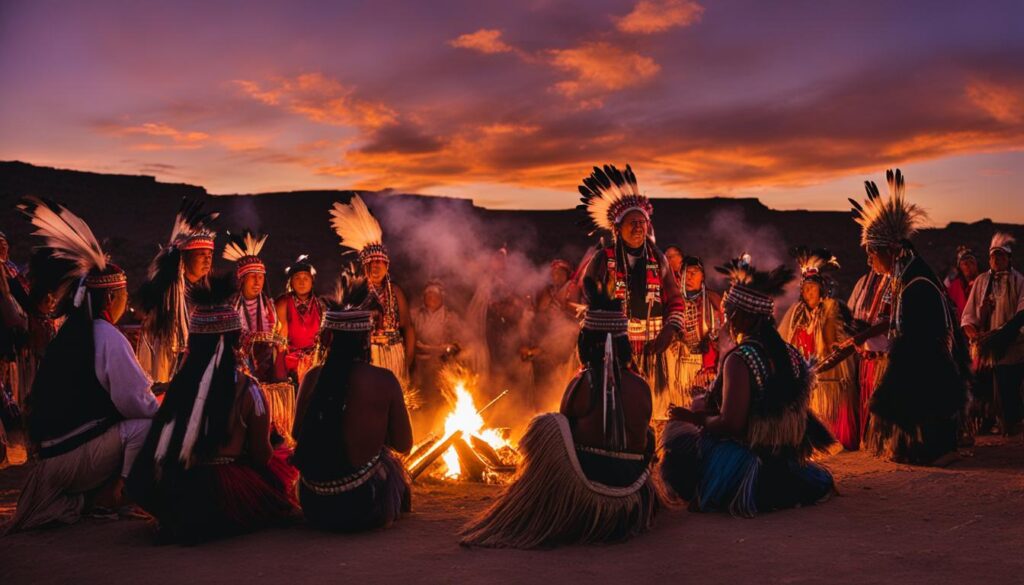
The preservation and continuation of Hopi customs and ceremonies are vital for maintaining the integrity of Hopi culture.
Hopi Identity: Resilience and Cultural Retention
Despite the challenges and pressures faced by the Hopi Tribe, they have displayed remarkable resilience in retaining their cultural identity. The Hopi people have managed to pass down their beliefs, customs, and language through generations, ensuring the preservation of their unique heritage. Their strong sense of identity provides them with the strength to confront modern influences and maintain their cultural practices.
“Our cultural beliefs and customs are the foundation of who we are as the Hopi Tribe. They have withstood the test of time, and we are committed to preserving them for future generations to come.”
In the face of social, economic, and political pressures, the Hopi people have remained steadfast in their commitment to preserving their cultural beliefs. The Hopi Tribe understands the significance of their traditions and their role in shaping their identity as a community.
Through ongoing efforts, such as community events, education programs, and intergenerational knowledge sharing, the Hopi people have ensured the continuity of their cultural practices. By passing down their customs and beliefs from one generation to the next, they safeguard the essence of what it means to be Hopi.
The Role of Language in Cultural Retention
Language plays a critical role in preserving cultural identity. The Hopi language, an integral part of Hopi culture, contains unique concepts and expressions that encapsulate their beliefs and values. Efforts to revitalize and teach the Hopi language are essential in maintaining the Hopi tribe’s cultural integrity.
By keeping their language alive, the Hopi people are not only preserving their rich linguistic heritage but also ensuring that their cultural beliefs and values are passed on accurately and authentically. The Hopi language serves as a vessel of cultural knowledge, connecting generations and reinforcing their collective identity.
Resistance to Assimilation
Throughout history, the Hopi Tribe has faced assimilation efforts that aimed to erode their cultural practices and beliefs. Despite these challenges, the Hopi people have resilience against assimilation, emphasizing the importance of cultural preservation.
By staying true to their heritage, the Hopi people resist the homogenizing forces of modern society. They actively engage in cultural ceremonies, participate in traditional practices, and continue to live according to the values passed down by their ancestors. This steadfast commitment to cultural retention ensures that the Hopi identity remains intact and vibrant.
| Challenges Faced | Strategies for Cultural Retention |
|---|---|
| Government assimilation policies | Active participation in cultural ceremonies and practices |
| Economic pressures | Community initiatives to promote traditional crafts and arts |
| Social influences | Education programs that emphasize Hopi history and cultural values |
Despite external pressures, the Hopi Tribe remains steadfast in preserving their cultural beliefs, customs, and language. Their resilience in the face of challenges serves as a testament to the profound importance of cultural retention. The preservation of the Hopi identity not only benefits their community but also contributes to the diversification and preservation of indigenous cultures globally.
Hopi Wisdom and Environmental Stewardship
Hopi wisdom reflects a deep understanding of the interconnectedness of all life and the importance of environmental stewardship. The Hopi Tribe’s cultural beliefs and practices provide valuable lessons for sustainable living and preserving the natural world. By embracing and learning from their wisdom, we can adopt a more holistic and respectful approach to the environment, ensuring a healthier planet for future generations.
“We are all connected. What we do to the Earth, we do to ourselves.”
The Hopi Tribe’s spiritual practices emphasize the harmony between humans and nature. Their belief in the sacredness of the Earth compels them to live in balance with the environment, cultivating sustainable agricultural practices and minimizing their ecological footprint. Through their deep reverence for nature, the Hopi offer invaluable teachings on the importance of preserving and protecting our planet.
The Hopi Corn Ceremony
One of the key ceremonies in Hopi culture is the Corn Ceremony, which symbolizes the tribe’s deep connection to the land and their agricultural practices. During this ceremony, the Hopi express gratitude for the harvest and offer prayers for a bountiful future. It serves as a reminder of the vital role that corn plays in their cultural beliefs, representing sustenance, prayer, and the embodiment of Hopi values.
The Hopi people understand that sustainable practices are essential for their own survival and the well-being of the Earth. They recognize that their actions have consequences and that preserving the natural world is crucial for future generations. By embodying this wisdom, the Hopi Tribe sets an example for all of us to become better stewards of the environment.
The Importance of Preserving Hopi Culture for Future Generations
Preserving Hopi culture is crucial for the well-being and identity of future generations. By maintaining our cultural beliefs, practices, and language, we can pass down valuable knowledge and wisdom to our descendants. Our Hopi traditions provide a sense of belonging, community, and connection to the land, which are essential for fostering a strong cultural identity. Investing in the preservation of Hopi culture is an investment in the future of our tribe and the valuable lessons we offer.
Our cultural beliefs, rooted in our ancient heritage, hold profound wisdom and insights into the interconnectedness of all life and the importance of environmental stewardship. Through the preservation of our cultural practices and ceremonies, we ensure that future generations continue to have access to these teachings and can learn from our ancestral wisdom.
By embracing our Hopi cultural beliefs, we instill in our youth a sense of pride, resilience, and a strong connection to their roots. Our cultural practices provide valuable guidance, teaching us respect for the land, compassion for all living beings, and the importance of living in harmony with nature. These teachings are essential for navigating an increasingly complex and interconnected world.
The Power of Cultural Identity
Our cultural beliefs and practices form the foundation of our identity as Hopi people. They shape our values, influence our decisions, and provide us with a sense of purpose. By preserving our culture, we ensure that future generations have a strong sense of self and belonging, enabling them to navigate the challenges of life with resilience and grace.
Our language, customs, and ceremonies are a testament to the rich history and wisdom of our ancestors. They remind us of who we are and where we come from, grounding us in a shared heritage that spans centuries. By passing down our cultural beliefs, practices, and language, we empower our youth to carry our legacy forward and contribute to the continued growth and vitality of our tribe.
The Value of Intergenerational Knowledge
Preserving Hopi culture is not just about preserving the past; it is about safeguarding our future. Our cultural beliefs and practices hold valuable knowledge and insights that can guide us in navigating the challenges of the modern world. By learning from the wisdom of our ancestors, we equip ourselves with the tools to address current and future issues, fostering a more harmonious and sustainable society.
Our cultural teachings offer guidance on how to live in balance with the environment, promoting sustainable practices and ecological stewardship. In a world grappling with environmental crises, our Hopi cultural beliefs serve as a powerful reminder of the importance of protecting and preserving the natural world for future generations.
Investing in the Future
Preserving our Hopi culture requires dedication, support, and investment from our community and beyond. By prioritizing resources for cultural preservation initiatives, educational programs, language revitalization efforts, and cultural exchange activities, we ensure that our heritage remains alive and vibrant.
Collaboration with educational institutions, museums, and cultural organizations can help amplify our voice, promote understanding, and raise awareness about the richness and significance of Hopi cultural beliefs. By sharing our traditions with the wider world, we foster appreciation for indigenous cultures, encourage dialogue, and contribute to a more inclusive and diverse society.
Preserving Hopi culture is an ongoing journey, requiring the commitment and engagement of individuals, communities, and institutions. It is a collective responsibility that allows us to honor our ancestors, celebrate our unique heritage, and provide future generations with the transformative power of cultural wisdom.
Preserving Hopi culture ensures the well-being and identity of future generations, allowing them to benefit from the wisdom of our ancestors and foster a strong cultural identity.
Conclusion
The Hopi Tribe’s beliefs, customs, and spiritual practices hold profound wisdom that offers valuable insights into the interconnectedness of all life and the importance of environmental stewardship. Preserving the rich heritage of the Hopi culture is not only crucial for the Hopi people themselves, but also for the benefit of all of humanity.
By embracing the wisdom of the Hopi Tribe and supporting initiatives aimed at preserving their cultural beliefs, we can learn valuable lessons about sustainability, cultural diversity, and our relationship with the natural world. The Hopi people’s resilience and commitment to their cultural identity serve as an inspiration to honor and respect indigenous cultures not only within the United States but around the globe.
Together, we can ensure that the Hopi Tribe’s beliefs and cultural practices continue to thrive, passing down their invaluable knowledge and wisdom to future generations. By doing so, we not only preserve their cultural heritage, but also gain a deeper understanding of our own place within the interconnected web of life.
FAQ
What are the core beliefs of the Hopi Tribe?
The Hopi Tribe has a deep spiritual connection to the land and believes in the oneness between humans and nature. Their beliefs are rooted in their ancient culture and shape their entire way of life.
How long has the Hopi Tribe resided in Northeastern Arizona?
The Hopi Tribe has resided in Northeastern Arizona for thousands of years, making them one of the oldest living cultures in documented history.
What role do ceremonies and customs play in Hopi spiritual practices?
Ceremonies and customs are an integral part of Hopi spiritual practices, addressing various aspects of life, such as fertility, harvest, and healing. They aim to maintain balance and harmony in the world and ensure the well-being of the community.
What are Hopi prophecies and how do they impact the tribe’s way of life?
Hopi prophecies provide insights into the future and guide the way of life for the Hopi Tribe. They often relate to the environment, natural disasters, and the overall well-being of humanity, emphasizing the importance of maintaining a harmonious relationship with nature.
How have assimilation efforts by the U.S. government affected the Hopi Tribe’s cultural beliefs?
The Hopi Tribe has faced significant assimilation efforts by the U.S. government throughout history, aiming to strip them of their cultural beliefs and traditions, including their religion. However, the Hopi people have managed to retain a strong sense of identity and resist assimilation.
How does the novel “The Man Who Killed the Deer” reflect Hopi beliefs?
The novel explores the importance of the Hopi belief in the sanctity of all life and the consequences of violating this belief. Through the story, readers gain insights into the wisdom and complexities of Hopi beliefs and cultural traditions.
What is the significance of agriculture in Hopi culture?
Agriculture plays a vital role in Hopi culture and spiritual practices. The Hopi people have developed unique and sustainable farming methods, with corn playing a central role in their culture, symbolizing sustenance, prayer offering, and the embodiment of Hopi heritage.
Why is the preservation of the Hopi language important?
The Hopi language is a key element of Hopi identity and culture. It encompasses unique concepts and worldviews deeply connected to Hopi cultural beliefs and traditions. Preserving the language is crucial for maintaining the cultural integrity of the tribe.
What challenges does the Hopi Tribe face in preserving their cultural beliefs?
The Hopi Tribe faces challenges from modern society, education, and economic factors that influence the younger generation’s inclination to stray from Hopi traditions. However, there are initiatives in place, such as educational facilities and language and culture preservation projects, working towards the preservation of Hopi culture.
Why is the preservation of Hopi culture valuable for all of humanity?
The preservation of Hopi culture offers valuable lessons for all of humanity, including a deep respect for the environment and a more harmonious relationship with nature. Understanding and appreciating Hopi culture can help foster a healthier planet and cultural diversity.
How do Hopi prophecies provide insights for the future?
Hopi prophecies often address environmental concerns, emphasizing the need for sustainable practices and harmony with nature. By heeding these prophecies and embracing Hopi beliefs, we can work towards a more sustainable and balanced future for all.
Why are Hopi customs and ceremonies significant in modern society?
Hopi customs and ceremonies serve as a reminder of the timeless wisdom and connection to nature. Participating in or learning about Hopi ceremonies can provide individuals with a deeper connection to the natural world and a greater appreciation for the interconnectedness of all living beings.
How have the Hopi people retained their cultural identity?
Despite facing assimilation efforts, the Hopi people have displayed remarkable resilience in retaining their cultural identity. They have passed down their beliefs, customs, and language through generations, ensuring the preservation of their unique heritage.
What can we learn from Hopi wisdom and environmental stewardship?
Hopi wisdom encompasses a deep understanding of the interconnectedness of all life and the importance of environmental stewardship. By embracing and learning from their wisdom, we can adopt a more holistic and respectful approach to the environment, ensuring a healthy planet for future generations.
Why is preserving Hopi culture important for future generations?
Preserving Hopi culture is crucial for the well-being and identity of future generations. It allows the Hopi people to pass down valuable knowledge and wisdom while fostering a strong cultural identity, sense of belonging, and connection to the land.

